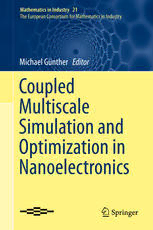Table Of ContentMathematics in Industry 21
The European Consortium for Mathematics in Industry
Michael Günther E ditor
Coupled
Multiscale
Simulation and
Optimization in
Nanoelectronics
MATHEMATICS IN INDUSTRY 21
Editors
Hans-GeorgBock
FrankdeHoog
AvnerFriedman
ArvindGupta
AndréNachbin
HelmutNeunzert
WilliamR.Pulleyblank
TorgeirRusten
FadilSantosa
Anna-KarinTornberg
THEEUROPEANCONSORTIUM
FORMATHEMATICSININDUSTRY
SUBSERIES
ManagingEditor
VincenzoCapasso
Editors
LuisL.Bonilla
MichaelGünther
RobertMattheij
HelmutNeunzert
OtmarScherzer
WilH.A.Schilders
Moreinformationaboutthisseriesat
http://www.springer.com/series/4650
Michael GuRnther
Editor
Coupled Multiscale
Simulation and Optimization
in Nanoelectronics
123
Editor
MichaelGuRnther
LehrstuhlfuRrAngewandte
Mathematik/NumerischeAnalysis
BergischeUniversitaRtWuppertal
Wuppertal
Germany
ISSN1612-3956 ISSN2198-3283 (electronic)
MathematicsinIndustry
ISBN978-3-662-46671-1 ISBN978-3-662-46672-8 (eBook)
DOI10.1007/978-3-662-46672-8
LibraryofCongressControlNumber:2015941321
MathematicsSubjectClassificationNumbers(2010):65M20,65L80,68N30,78M34,93A30,97U50
SpringerHeidelbergNewYorkDordrechtLondon
©Springer-VerlagBerlinHeidelberg2015
Thisworkissubjecttocopyright.AllrightsarereservedbythePublisher,whetherthewholeorpartof
thematerialisconcerned,specificallytherightsoftranslation,reprinting,reuseofillustrations,recitation,
broadcasting,reproductiononmicrofilmsorinanyotherphysicalway,andtransmissionorinformation
storageandretrieval,electronicadaptation,computersoftware,orbysimilarordissimilarmethodology
nowknownorhereafterdeveloped.
Theuseofgeneraldescriptivenames,registerednames,trademarks,servicemarks,etc.inthispublication
doesnotimply,evenintheabsenceofaspecificstatement,thatsuchnamesareexemptfromtherelevant
protectivelawsandregulationsandthereforefreeforgeneraluse.
Thepublisher,theauthorsandtheeditorsaresafetoassumethattheadviceandinformationinthisbook
arebelievedtobetrueandaccurateatthedateofpublication.Neitherthepublishernortheauthorsor
theeditorsgiveawarranty,expressorimplied,withrespecttothematerialcontainedhereinorforany
errorsoromissionsthatmayhavebeenmade.
Printedonacid-freepaper
Springer-VerlagGmbHBerlinHeidelbergispartofSpringerScience+Business Media(www.springer.
com)
AngeloMarcelloAnile(1948–2007)
DedicatedtoAngelo MarcelloAnile,
thescientist,colleague,anddear friend.
Withouthisenthusiasm,mediativeattitude,
andextensiveknowledge, COMSONwould
neverhavebeen possible.
Preface
Circuit design based on numerical simulation relies heavily on mathematical
methods. As a result, relations have long since been established between the
microelectronics industry and university groups specializing in simulations for
semiconductor processes and devices, electromagnetics and electronic circuits.
State-of-the-artmethodsfromthefieldsofappliedandnumericalanalysis,aswell
as newly developed dedicated algorithms, have facilitated the large-scale use of
simulations,therebyenablingtheindustrytoreachitscurrenthighstateoftheart.
Designingcomplexintegratedcircuitscallsforadequatesimulationandoptimi-
sation tools. The current design approach involves simulations and optimizations
in different physical domains (device, circuit, thermal, electromagnetic) and in
electrical engineering disciplines (logic, timing, power, crosstalk, signal integrity,
system functionality). The physical aspects are essential to characterizing circuit
behaviorfromanelectricalengineeringandsystem-orientedstandpoint.
Accordingly, the main scientific objectives of the COMSON (COupled Multi-
scaleSimulationandOptimizationinNanoelectronics)projectwereasfollows:
(cid:129) To develop new descriptive models that take these mutual dependencies into
account
(cid:129) To combine these models with existing circuit descriptions in new simulation
strategies
(cid:129) Todevelopnewoptimizationtechniquesthatwillaccommodatenewdesigns
COMSON was a Marie Curie Research Training Network supported by the
EuropeanCommissionintheprogrammeStructuringtheEuropeanResearchArea,
partoftheEU’sSixthFrameworkResearchProgramme.Theprojectwasinitiated
by the three major European semiconductor companies – Infineon Technologies
AG,laterreplacedbyitsspin-offQimondaAGofNeubiberg,Germany;Koninklijke
PhilipsN.V., later replacedby its spin-offNXP SemiconductorsNetherlandsN.V.
of Eindhoven, the Netherlands; and STMicroelectronics of Catania, Italy – who
worked in cooperation with five European academic partners in Applied Mathe-
matics and Electrical Engineering with considerable experience in the simulation
and optimization of integrated circuits – the University of Wuppertal, Germany
vii
viii Preface
(coordinator);EindhovenUniversityofTechnology,theNetherlands;Universityof
Catania,Italy;UniversityofCalabria,Italy;andUniversityPolitehnicaofBucharest,
Romania.Therationalebehindtheprojectandthisbookwasdescribedasfollows:
Performing the step from micro- to nanoelectronics, the semiconductor industry is con-
fronted with very high levels of integration, introducing coupling effects that were not
observedbefore.Currently,thecomplexityofthisproblemisbeyondthecapabilitiesofany
industrial software and design environment. Furthermore, in the near future, researchers
mustunderstandallaspectsoftheproblemsfacedbyindustry.
Tomeetthesenewscientificandtrainingchallenges,theCOMSONprojecton“COupled
MultiscaleSimulationandOptimizationinNanoelectronics”mergestheknow-howofthe
threemajorEuropeansemiconductorcompanieswiththecombinedexpertiseofuniversity
groupsspecializedindevelopingadequatemathematicalmodels,numericalschemes,and
e-learning facilities, covering all relevant fields of interest. In COMSON, academia and
industry jointheirefforts torealize acommon Demonstrator Platform: ontheone hand,
to test mathematical methods and approaches, so as to assess whether they are capable
of addressing the industry’s problems; on the other hand, to adequately educate young
researchersbyprovidinghands-onexperiencewithstate-of-the-artproblems,andbeyond.
The editor thanks his colleagues for their valued contributions in the different
chapters of this handbook: Roland Pulch of Greifswald, Germany (PDAE mod-
elling);AndreasBartelofWuppertal,Germany,andSebastianSchöpsofDarmstadt,
Germany (dynamic iteration); E.J.W. ter Maten of Eindhoven, the Netherlands
(MOR);SalvatoreRinaudoofCatania,Italy(optimization);GeorgDenkofMunich,
Germany(demonstratorplatform);andGiuseppeAlìofCosenza,Italy(e-learning).
Wuppertal,Germany MichaelGünther
September2014
Contents
PartI Introduction
1 TheCOMSONProject ...................................................... 3
MichaelGüntherandUweFeldmann
1.1 TrendsinMicroelectronics............................................. 3
1.2 ScopeoftheCOMSONProject........................................ 4
1.3 Methodology............................................................ 5
1.3.1 TheDemonstratorPlatform................................... 6
1.3.2 E-Learning..................................................... 9
1.4 Modelling,SimulationandOptimisation .............................. 9
1.4.1 PartialDifferentialAlgebraicEquations ..................... 10
1.4.2 DynamicIteration............................................. 10
1.4.3 ModelOrderReduction....................................... 11
1.4.4 Optimisation................................................... 11
References..................................................................... 12
PartII PartialDifferentialAlgebraicEquations
2 PDAEModelingandDiscretization........................................ 15
GiuseppeAlì,MassimilianoCulpo,RolandPulch,
VittorioRomano,andSebastianSchöps
2.1 IntroductiononModelingandPDAEs................................. 15
2.1.1 MathematicalModelinginNanoelectronics................. 16
2.1.2 ClassificationofPDAEModels............................... 18
2.2 Modeling,AnalysisandDiscretizationofCoupledProblems........ 21
2.2.1 RefinedModelingofNetworkswithDevices................ 21
2.2.2 Electro-ThermalEffectsattheSystemLevel................ 45
2.2.3 MultiphysicsModelingviaMaxwell’sEquations ........... 64
2.2.4 ThermalandQuantumEffectsinSemiconductors........... 78
References..................................................................... 99
ix

